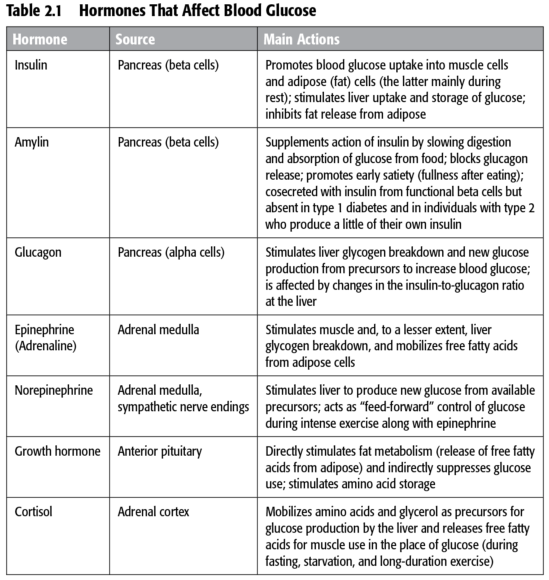Understand hormonal responses to exercise
This is an excerpt from Athlete’s Guide to Diabetes, The by Sheri Colberg-Ochs.
The human body only has insulin to lower blood glucose but has five hormones that raise it (with some overlap). This hormone redundancy tells you that, at least from a survival standpoint, your body is desperate to make sure you do not run out of blood glucose; it is not as concerned about you having too much. Insulin is an important hormone for regulating your body's storage of fuels (carbohydrate, fat, and protein) after you eat. It tells your insulin-sensitive cells (mainly your muscle and fat cells but also your liver) to take up glucose and fat to store them for later as muscle and liver glycogen (the storage form of glucose) as well as stored fat. During exercise, any insulin in your bloodstream can make your muscles take up extra blood glucose. In people who have a pancreas that functions normally, insulin levels typically decrease during exercise, and levels of a hormone called glucagon (released from the alpha cells of the pancreas) rise to stimulate glucose release.
Your blood glucose levels are managed by your liver, which would normally respond to the relative amounts of insulin and glucagon (table 2.1). Insulin and glucagon released from the pancreas go directly to the liver via the portal circulation. After a meal, high insulin and glucose levels tell the liver to store glucose for later use; fasting overnight or doing extended exercise leads to glucagon signaling the liver to release glucose. How people with type 1 diabetes respond hormonally to exercise is a major issue: the insulin and glucagon at the level of the liver are seldom perfectly normal because their insulin is injected or pumped under the skin rather than released directly from the pancreas.

People with type 1 diabetes have an altered hormonal response to exercise when their peripheral insulin is relatively high; lowering the circulating level of insulin helps normalize their hormone response.
All exercise causes the release of hormones that increase the production of glucose by your liver and lower your muscular use, based on how long and hard you exercise. Easy and moderate activities only release a small amount of glucose-raising hormones (unless you do them for a very long duration), but intense exercise such as heavy resistance training, sprinting, or high-intensity intervals causes an immediate rise in your blood glucose and leads to an exaggerated release of hormones. These hormones include adrenaline (formally known as epinephrine) and norepinephrine, which are released by the sympathetic nervous system (allowing your body to respond to physical or mental stressors with an increased heart rate), as well as glucagon, growth hormone, and cortisol (see table 2.1). The effects of these glucose-raising hormones can easily exceed your body's immediate need for glucose, especially because high-intensity exercise may not last long. As a result, your blood glucose often rises during and after short bouts of intense activity.
Intense exercise can cause a large increase in blood glucose because of your body's exaggerated release of glucose-raising hormones such as adrenaline and glucagon.
You may be more insulin resistant immediately after intense exercise and for a few hours due to these hormones. In one study, after near-maximal cycling to exhaustion, one group of people with type 1 diabetes on insulin pumps experienced elevated blood glucose levels for nearly 2 hours. Similarly, in exercisers with type 2 diabetes, blood glucose also rose for 1 hour in response to maximal cycling, as did their insulin levels (because their bodies still produced their own insulin). You may need some supplemental insulin to bring your blood glucose back down (albeit less than normal), or it may drop slowly over time on its own. After these hormones wane, your blood glucose may easily drop later when your body is working hard to restore the muscle glycogen you used during the activity. Be on the lookout for later-onset lows in these cases.
SHOP

Get the latest insights with regular newsletters, plus periodic product information and special insider offers.
JOIN NOW


